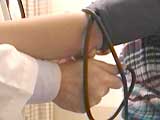High Blood Pressure in Children
 Kids need hugs everyday, but there is another kind of squeeze they should feel once a year. That’s the squeeze of a blood pressure monitor on their arm. Here’s why regular blood pressure checks are crucial to your child’s health.
Kids need hugs everyday, but there is another kind of squeeze they should feel once a year. That’s the squeeze of a blood pressure monitor on their arm. Here’s why regular blood pressure checks are crucial to your child’s health.
Amber says, “I’ve done track. This year I’m doing swimming, and I’m also trying out for volleyball.”
Amber loves sports, but five years ago she wasn’t able to be on the team. In third grade, she was diagnosed with high blood pressure. Her blood pressure was 140/90 compared to an average adult’s rate of 120/80. Her mom, Ronda, remembers how tough it was. “Her chest would even feel as though, after any type of physical activity, like it was going to jump out of her chest. What a frightening feeling for a child,” Ronda says.
The medical community once believed high blood pressure in children was a side effect of other diseases, but now they know some children have it for unknown reasons.
Joseph Flynn, M.D., a pediatrician, says that’s why it’s important to have your child’s pressure checked regularly. He recommends once a year starting at age three.
Dr. Flynn says, “If your child has high blood pressure that is never picked up, then there’s a very high chance they could end up with early heart disease or early kidney disease.”
Amber tried medications but has now gotten her blood pressure under control by changing her diet. “So I don’t consume as much salt and everything, and I eat a lot of healthier foods,” she says. She also exercises.
Ronda says, “We would rather see her out physically active at this point than doing homework.” That’s quite a statement from a mom who’s also a teacher.
Dr. Flynn says if you have high blood pressure, then your child is at an increased risk of developing it. A child’s blood pressure does change as they grow. Your doctor should have guidelines based on age, sex, weight and height.

